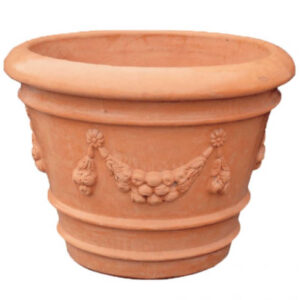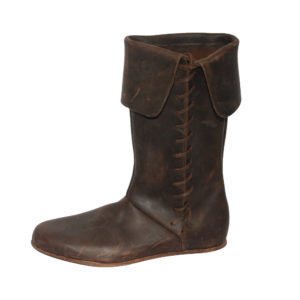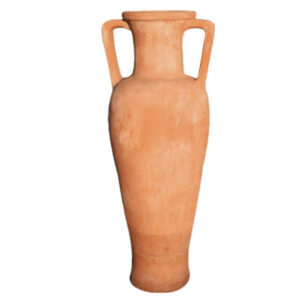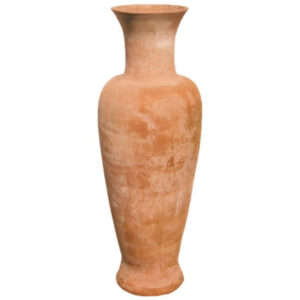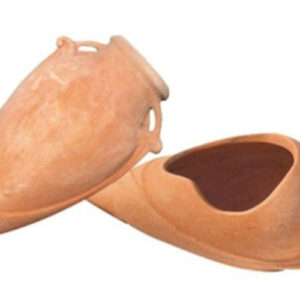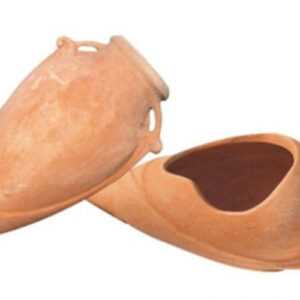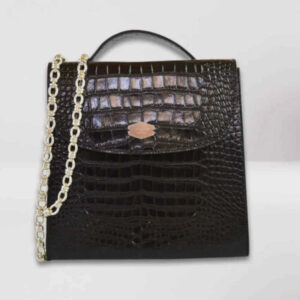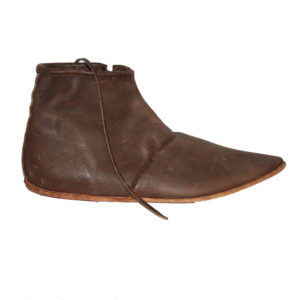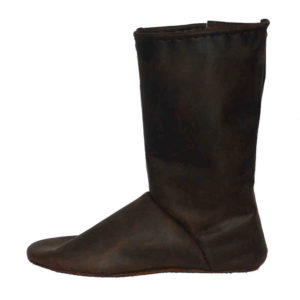-
ALBA FESTONATO VASE
ALBA FESTONATO VASE
ALBA FESTONATO VASE is sold in various sizes.
Choose the model that matches your favorite mirures:
MODEL : VASE ART- 113-1 – Dimensions : cm. 50Øx42 h
MODEL : VASE ART- 113-1 – Dimensions : cm. 60Øx52 h
MODEL : VASE ART- 113-1 – Dimensions : cm. 70Øx61 hALBA FESTONATO VASE.
The Alba Festonato vase is a terracotta vase suitable for decorating your gardens or terraces.
This Impruneta terracotta vase is handmade by our artisans, and is characterized by a particularly elongated shape,
embellished with two cords that make it particularly elegant and harmonious.It is suitable for containing any type of flower, plant or shrub, the good breathability of Impruneta terracotta combined
with thermal insulation and the slight release of moisture from watering, it keeps the roots and the plants themselves in excellent health.
The French vase, in addition to its function as a planter, is a valuable piece of furniture,
giving beauty and elegance to any type of environment, both internal and external. -
ALFIERE ENSIGN
ALFIERE : ENSIGN SHOE
ALFIERE – Standard bearer shoe from standard bearer
HISTORICAL PERIOD: 13th to 15th century
GEOGRAPHICAL AREA: EUROPEDESCRIPTION
Boots in greased leather, reinforced in the heel and on the front.
Modeled reverse.
Leather sole and lacing with leather lace.
Hand-stitched upper EEVENTS:
Used on the occasion of historical parades and parades, having, the one who wears them, the role of banner holder or flag.198,00€ + VATALFIERE ENSIGN
198,00€ + VAT -
ALIANO
ALIANO Moccasin with classic tassels
BESPOKE- ALIANO-MOCCASIN
ALIANO MOCASSIN – Classic line Made to measure handmade shoe for men
BESPOKE shoes are all handmade.
Request a quote to contact the shoemaker.
BESPOKE will contact you to fulfill all your wishes to have a unique pair of shoes.BESPOKE Aliano moccasin made to measure by hand.
Footwear for every day, work and free time, light and very comfortable.BESPOKE Aliano are all handmade shoes.
Each pair of shoes is unique and will reflect your personality.
Agree with the shoemaker the pair of shoes you prefer and how you want them.
The leather, the colors, the lining and any your wishesThe shoes that will arrive at your home are unique pieces.
Manual skill: it is unique stitching, shades of specific colors,
like other small details that make BESPOKE shoes authentic works of art. -
AMPHORA TERRACOTTA WITH HANDLES
AMPHORA TERRACOTTA WITH HANDLES
AMPHORA TERRACOTTA ART- 800-2
Dimensions: cm. 33Øx99 hThe Amphora with handles is a terracotta amphora, suitable for decorating your gardens, your terraces, your homes.
The amphora with handles of terracotta from Impruneta is handmade by our artisan workshops, and is completely smooth,
without any decoration, except for the square-shaped handles in the version with handles.The good breathability of Impruneta terracotta is suitable for holding any type of flower,
plant or shrub combined with thermal insulation and the slight release of moisture from watering,
it keeps the roots and the plants themselves in excellent health.The amphora with handles, in addition to the function of a planter,
is a valuable piece of furniture, which gives beauty and elegance to your garden or home. -
AMPHORA-800
AMPHORA TERRACOTTA – SIMPLE WITHOUT HANDLES
AMPHORA TERRACOTTA ART- 800
Dimensions: cm. 35Øx100 hThe Amphora 800 simple without handles is a terracotta amphora, suitable for decorating your gardens, your terraces, your homes.
The amphora of terracotta from Impruneta is handmade by our artisan workshops, and is completely smooth,
without any decoration, except for the square-shaped handles in the version with handles.The good breathability of Impruneta terracotta is suitable for holding any type of flower,
plant or shrub combined with thermal insulation and the slight release of moisture from watering,
it keeps the roots and the plants themselves in excellent health.The amphora simple without handles, in addition to the function of a planter,
is a valuable piece of furniture, which gives beauty and elegance to your garden or home.Maximum internal height 45.0 cm
20.0 cm diameter opening for smoke outlet -
AMPHORA-805
AMPHORA TERRACOTTA – 805 OPEN or CLOSED
AMPHORA TERRACOTTA ART- 805
Dimensions: cm. 31Øx57 hThe Amphora open or closed is a terracotta amphora, suitable for decorating your gardens, your terraces, your homes.
The amphora with handles of terracotta from Impruneta is handmade by our artisan workshops, and is completely smooth,
without any decoration, except for the square-shaped handles in the version with handles.The good breathability of Impruneta terracotta is suitable for holding any type of flower,
plant or shrub combined with thermal insulation and the slight release of moisture from watering,
it keeps the roots and the plants themselves in excellent health.The amphora 805-1 that could be open or closed, in addition to the function of a planter,
is a valuable piece of furniture, which gives beauty and elegance to your garden or home. -
AMPHORA-805-1
AMPHORA TERRACOTTA – 805-1 OPEN or CLOSED
AMPHORA TERRACOTTA ART- 805-1
Dimensions: cm. 41Øx80 hThe Amphora open or closed is a terracotta amphora, suitable for decorating your gardens, your terraces, your homes.
The amphora with handles of terracotta from Impruneta is handmade by our artisan workshops, and is completely smooth,
without any decoration, except for the square-shaped handles in the version with handles.The good breathability of Impruneta terracotta is suitable for holding any type of flower,
plant or shrub combined with thermal insulation and the slight release of moisture from watering,
it keeps the roots and the plants themselves in excellent health.The amphora 805-1 that could be open or closed, in addition to the function of a planter,
is a valuable piece of furniture, which gives beauty and elegance to your garden or home. -
ANIMA clutch bag
Anima Clutch bag in crocodile leather
The crocodile print clutch bag Anima is a timeless classic.
Original in its shape, elegant and versatile.
This bag is ideal to be combined with an elegant look for evenings and special events, but also for leisure.- Exterior: in genuine vegetable tanned leather, crocodile print;
- Inside: fully lined in cream color, with two pockets, one open and one with zip;
- Accessories included: nickel free shoulder strap.
501,50€ – 590,00€ + VATANIMA clutch bag
501,50€ – 590,00€ + VAT -
ARCHER ARCIERE
ARCHER: ARCHER SHOE
Shoe worn by archers (Arcieri)
HISTORICAL PERIOD: from the 11th to the 14th century
GEOGRAPHICAL AREA: EUROPEDESCRIPTION :
Boot in greased leather.
Upper all hand-sewn.
Buttress.
Front unlined.
Greased leather sole, lacing with leather laces.EVENTS:
Shoe worn by archers, which allowed them to move easily on all types of terrain.
Today, in re-enactments, these shoes make a fine show of themselves for their beauty, workmanship and practicality.155,00€ + VATARCHER ARCIERE
155,00€ + VAT -
ARMIGER – ARMIGERO
ARMIGER – ARMIGERO : WARRIOR SHOE
HISTORICAL PERIOD: from the XII to the XIV century
GEOGRAPHICAL AREA: EUROPEDESCRIPTION :
In sturdy greased leather.
Entirely hand-sewn including the sole.
Lacing with leather laces.
Buttress.EVENTS:
Shoe used in the past by the one who carried weapons or was armed, ready to fight, or by a warrior.
Today in the re-enactments of the Middle Ages.410,00€ + VATARMIGER – ARMIGERO
410,00€ + VAT -
ARMONY BAG
Armony Clutch bag with sheridan decorations
Armony is a clutch bag with an elegant touch and embellished with sheridan decorations.
This clutch bag is perfect for ceremonies and special occasions.
Original in its shape, elegant and versatile.Armony bag is ideal to be combined with an elegant look for evenings
and special events but also for leisure time.
Exterior: 100% vegetable real leather, completely hand-sewn and engraved;
Interior: fully lined in cream color, with pocket closed by zip;
Accessories included: wrist strap.501,50€ – 590,00€ + VATARMONY BAG
501,50€ – 590,00€ + VAT -
Australian Crazy horse leather hat
Leather Australian Crazy Horse Hat – Made in Tuscany
The Australian Machiavelli Crazy Horse Hat – is made of Crazy horse oiled leather for any occasion or ride with or without rain.
The Machiavelli Crazy Horse natural Australian style riding hat for young people and any age.
Hat made of high quality vegetable tanned leather.
The internal of the hat is made of soft and elegant leather with attention
to the smallest details by Italian artisans from the Florentine Tuscan area.
The hat has a woven leather band on the outside and has a soft elastic closure.
The brim is 7 cm.
On the outside it has Crazy Horse waterproof oily leather to wear it during riding and life with horses.
Definitely suitable for horse sports such as horse riding but also horseback riding in the open air or woods.Dimensions:
Measures: XS, S, M, L, XL, XXL123,00€ + VATAustralian Crazy horse leather hat
123,00€ + VAT
Handmade made in Italy
Handicraft and Made in Italy
Italian handmade or craftsman follows the spirit that combines art and practicality.
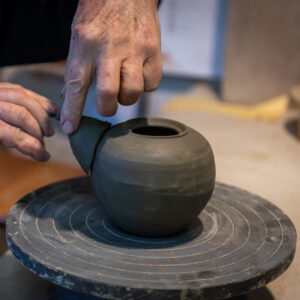
Handmade the vero Made in Italy
The evolution of thought, customs and knowledge is very rapid.
If on the one hand we witness the massification of consumption and the disappearance of ideologies.
On the other there is also the reaction of those who want to express themselves again and exclusively through their cultural and artistic identity.
This is basically the definition of a craftsman: a free man, whose work does not necessarily have to be linked to traditional or usual schemes.
He must not simply perpetuate fashions: when inventiveness is added to skill, the craftsman is projected towards new directions and dimensions of human activity, whatever his field is.
Craftsman: free spirit
The craftsman is a free and creative artist and with this predisposition of mind reflects the “Italian” way of life, which avoids schemes and “organizational cages”: becoming a craftsman is therefore a real vocation.
Like the ice cream maker and the pastry chef, who possess qualities of great aesthetic balance and a sense of proportion and color, creating sculptural works and perfect architectural representations.
Even if edible; or the jeweler, able to create ornamental masterpieces, unique pieces that distinguish the wearer.
Or the inventor of new games that cheer up children or practical objects to facilitate our everyday life.
But we must not forget the “artisan of the pen”, an all-round artist: journalist, designer, cartoonist and storyteller. Also «The poet – wrote Carducci – is a great craftsman …», or rather a great craftsman.
Craftsmanship is art
- Fashion : emblem of made in Italy, to give a form of beauty not only to the dress, but also to the wearer. Dress born, therefore, not only as a shelter from bad weather or for a sense of modesty, but also to satisfy an aesthetic need. In the field of fashion, the craftsman combines beauty, comfort and practicality.
- Furniture: the art of beautifying the environment. After the glories of antiquity, the eighteenth-century Venetian splendors, the return of the neoclassical, the liberty … today we find both a rustic and modern craftsmanship, a manifestation of popular costume and folklore, according to seafaring, mountain or peasant models, which have their roots in our millenary culture.
Handicraft is an ancient craft
Ceramics, glass and the like: the potter often works in a millenary workshop in one of the small towns scattered around Italy and with slow and measured movements he takes the piece of clay and places it on the lathe (the same pushed by the hocks of his avi), molds it, inflates it, engraves circles and widens its mouth, finally attaches the handles, creating a unique object of its kind.
Goldsmith’s and jewelry: by jewel we mean any precious object created by man, be it ring, necklace, bracelet or other, whose preciousness and rarity, moreover, can be dissociated from intrinsic value, referring exclusively to the artistic handcraft contribution.
Craftsmanship is a timeless profession
Iron: in addition to the manufacture of weapons, due to its tenacity and malleability it has been used in countless works. Blacksmith art led to the creation of the first large wrought iron gates, then reaching its peak in the Baroque period. Today many artisans scattered throughout Italy delight in this art.
Leather goods and leather processing: today’s centers of artisanal production correspond geographically to the traditional of the sixteenth century and Tuscany in primis. The uses are manifold, from bookbinding to accessories; among the latest items of classic leather goods, we find the lady’s bag, which derives from the saddle leather saddlebag, intended to contain the objects of use for grooming the horse, equivalent to the toolbox of our car.
Craftsmanship is history
Restoration: Giorgio Vasari, painter, architect and historian, violently lashed out against any type of restoration, only to then carry it out himself on some of his works.
To the dilemma about the legitimacy of the restoration of ancient works, triggered by numerous imperfectly executed works, it was decided that it was better to restore rather than permanently lose masterpieces rich in history. Initially, mostly pictorial and statuary restorations were carried out, but over time that of restoration has become a precious and indispensable industry, given the urgent need to keep our artistic heritage intact, which is not limited, as one may mistakenly think, to the content of the museums, but it extends to the whole social, artisan and architectural fabric of our nation.
Craftsmanship is the backbone of Made in Italy.
Each region has its own handicraft, characterized by typical peculiarities and peculiarities, an expression of history and culture.



